Intel Core i5-12400 Review: Alder Lake's Gaming Coup De Grace
Mid-range gaming has a new champion.

Intel hasn't officially announced the $199 Core i5-12400 and the chips aren't supposed to be available at retail yet, but that didn't stop us from snagging a chip and putting it to the test. We found that the Alder Lake Core i5-12400 delivers a stunning level of performance in our CPU benchmarks, beating all comparable Ryzen chips and even several of the more expensive models. Furthermore, with the right tuning, it's even faster at gaming than the previous-gen $549 Core i9-11900K flagship, raising the bar for mid-range gaming chips as it joins our list of the Best CPUs for gaming.
Intel's 65W Core i5 SKUs have long been the company's best mid-range chips for gamers. The Core i5-12400, though currently not officially announced, is expected to land with a similar $185 recommended price as its predecessor. The six-core i5-12400's potent combination of price and performance, not to mention a reportedly vastly-improved stock cooler, will dominate the $170 to $200 price range.
AMD abandoned the sub-$200 market when it launched its Ryzen 5000 processors, leaving its older processors to hold the line. Oddly enough, the aging Ryzen 5 3600X and 3600 will remain the go-to competitors for the 12400 even though they debuted nearly two and a half years ago. Sure, AMD released the Ryzen 5 3600XT a year later, but the overpriced XT chips barely brought any meaningful performance improvements and remain hard to find.
For now, AMD's lowest point of entry into its Zen 3-powered Ryzen 5000 series comes in the form of the $259 Ryzen 5 5600G. This APU is the best value on the market if you're looking to game at lower resolutions without a discrete GPU. But aside from gaming on the iGPU, it can't compete with the Core i5-12400 and comes at a far higher price point.
| Row 0 - Cell 0 | Price | Cores | Threads | P-Core Base/Boost | E-Core Base/Boost | TDP / PBP / MTP | DDR4-3200 | L3 Cache |
| Core i9-12900K / KF | $589 (K) - $564 (KF) | 8P + 8E | 16 Cores / 24 Threads | 3.2 / 5.2 GHz | 2.4 / 3.9 GHz | 125W / 241W | DDR4-3200 / DDR5-4800 | 30MB |
| Core i7-12700K / KF | $409 (K) - $384 (KF) | 8P + 4E | 12 Cores / 20 Threads | 3.6 / 5.0 GHz | 2.7 / 3.8 GHz | 125W / 190W | DDR4-3200 / DDR5-4800 | 25MB |
| Core i5-12600K / KF | $289 (K) - $264 (KF) | 6P + 4E | 10 Cores / 16 Threads | 3.7 / 4.9 GHz | 2.8 / 3.6 GHz | 125W / 150W | DDR4-3200 / DDR5-4800 | 16MB |
| Core i5-12400 / F | $192-$199 | $167-$174 (F) | 6P + 0E | 6 Cores / 12 Threads | 4.4 / ~2.5 GHz | n/a | 65W / 117W | DDR4-3200 / DDR5-4800 | 18MB |
That leaves Intel unchecked in the value segment, adding to the company's newfound dominance with the Alder Lake chips that even outperform more expensive Ryzen 5000 chips. As we can see with the $589 Core i9-12900K vs $799 Ryzen 9 5950X, the $408 Core i7-12700K vs $549 Ryzen 9 5900X, and the $289 Core i5-12600K vs $390 Ryzen 7 5800X (click the links for the full rundown), Alder Lake truly punches above its pricing weight class.
However, platform pricing has been a sore point for the Alder Lake family. While Intel's chips are less expensive than AMD's, the company currently only has its expensive Z690 motherboards on offer, reducing its value proposition for the lower-end processors. However, that's rumored to change later this week when B660 motherboards come to market, providing a great pairing for the Core i5-12400 and easing platform pricing concerns.
Surprisingly, Alder Lake's performance advantages come even without its support for DDR5 memory and PCIe 5.0 interfaces (both of which Intel brought to market first). You can use standard DDR4 memory and PCIe 4.0 devices to unlock superior performance over AMD's aging AM4 platform. We suspect that most B- and H-series boards will leverage less-expensive DDR4 memory due to ongoing DDR5 shortages, so a Core i5 system paired with a B660 motherboard could be the killer value combo.
Alder Lake also brings another innovation — the hybrid x86 design represents the company's most disruptive architectural shift in a decade. The higher-end Alder Lake chips combine big and fast Performance cores (P-cores) with clusters of small and powerful Efficiency cores (E-cores) that chew through background processes. The Golden Cove architecture powers the 'big' P-cores, while the 'little' E-cores come with the Gracemont architecture.
However, the Core i5-12400 doesn't have a hybrid architecture. Instead, it comes with a more traditional design and only has six P-Cores active, so it doesn't use Gracemont-based cores for background tasks. That means this six-core 12-thread processor doesn't need Intel's new Windows 11-exclusive Thread Director technology to place workloads on the correct cores. As a result, unlike Intel's hybrid models, the 12400 is just as potent in Windows 10 as it is in Windows 11.
As you'll see in our benchmarks below, the 65W Core i5-12400 is a stellar gaming chip that easily outperforms all of AMD's competing chips. In fact, the $185 Core i5-12400 is faster than the $299 Ryzen 5 5600X in gaming. After tuning, the 12400 is also faster than the Core i9-11900K at gaming, courtesy of Intel's memory overclocking support on B-series motherboards. Overall, the Core i5-12400 is the uncontested new mid-range gaming champ.
This is a review of an unreleased product, so we don't have all the official details yet. But we have the chip, which tells us everything we need to know about performance. We also tested the 12400 with overclocked memory and unlimited power settings, which provides a nice bit of uplift. So let's take a quick look at the specs we know, then get to the benchmarks.
Intel Alder Lake-S Core i5-12400 Specifications and Pricing
We have deep-dive coverage of the Alder Lake SoC design and core microarchitectures here, along with a broader overview in our Alder Lake all we know article. Additionally, Intel has removed its 'TDP' (Thermal Design Point) nomenclature from the spec sheets, and now assigns a Processor Base Power (PBP) value in its place. The company also added a secondary Maximum Turbo Power (MTP) value to the spec sheets to represent the highest power level during boost activity. You can read more about that change here.
Intel fabs Alder Lake on the 'Intel 7' process. We previously knew this 'Intel 7' manufacturing tech as 10nm Enhanced SuperFin, but Intel recently renamed its process nodes to match industry nomenclature. Technically, this is the second generation of Intel's 10nm process, but it's a first for desktop PCs.
| Row 0 - Cell 0 | Price | Cores | Threads | P-Core Base/Boost | E-Core Base/Boost | TDP / PBP / MTP | Memory Support | L3 Cache |
| Core i7-12700K / KF | $409 (K) - $384 (KF) | 8P + 4E | 12 Cores / 20 threads | 3.6 / 5.0 GHz | 2.7 / 3.8 GHz | 125W / 190W | DDR4-3200 / DDR5-4800 | 25MB |
| Ryzen 7 5800X | $449 | 8P | 16 threads | 3.8 / 4.7 GHz | - | 105W | DDR4-3200 | 32MB |
| Core i5-12600K / KF | $289 (K) - $264 (KF) | 6P + 4E | 10 Cores / 16 threads | 3.7 / 4.9 GHz | 2.8 / 3.6 GHz | 125W / 150W | DDR4-3200 / DDR5-4800 | 16MB |
| Ryzen 5 5600X | $299 | 6P | 12 threads | 3.7 / 4.6 GHz | - | 65W | DDR4-3200 | 32MB |
| Ryzen 5 5600G | $259 | 6 / 12 | 3.9 / 4.4 GHz | - | 65W | DDR4-3200 | 16MB |
| Core i5-12400 / F | $192-$199 | $167-$174 (F) | 6P + 0E | 6 Cores / 12 Threads | 4.4 / ~2.5 GHz | - | 65W / 117W | DDR4-3200 / DDR5-4800 | 18MB |
| Core i5-11400 / F | $182 - $157 | 6 / 12 | 2.6 / 4.2 | - | 65W | DDR4-2933 | 12MB |
| Ryzen 5 3600X | $240 | 6 / 12 | 3.8 / 4.4 | - | 95W | DDR4-3200 | 32MB |
| Ryzen 5 3600 | $200 | 6 / 12 | 3.6 / 4.2 | - | 65W | DDR4-3200 | 32MB |
All Alder Lake chips support DDR4-3200 or up to DDR5-4800 memory, but caveats apply. PCIe support will vary by motherboard, but Alder Lake chips expose up to 16 lanes of PCIe 5.0 (technically for storage and graphics only, no networking devices) and an additional four lanes of PCIe 4.0 from the chip for M.2 storage.
We don't have the full official specs for the Core i5-12400 yet. Instead, we're relying upon what we've seen in numerous leaks and what we've observed in our test environment. The 12400 comes with a 65W PBP (base) and 117W MTP (peak) power rating. We clocked the chip running at a 2.5 GHz base and boosting up to 4.4 GHz. The chip also comes with 18 MB of L3 cache.
The Core i5-12400 is a locked chip, meaning it isn't overclockable. However, Intel supports memory overclocking on Z690 and B660 motherboards (Z690 doesn't make sense for this class of chip, though). As you'll soon see, manipulating the power limits serves as a quasi-overclock that can eke out some additional performance in some gaming and threaded work.
The standard Core i5-12400 comes with the UHD Graphics 730 engine with 24 EUs. We clocked it running at 300 / 1400 MHz base/boost frequencies. If you're looking to save some coin, the graphics-less Core i5-12400F will come with a $25 price reduction (if tradition holds) and have the same specs as the 12400, which is incredibly attractive if you plan on using a discrete graphics card. Notably, you will lose Quick Sync capabilities and the iGPU fallback that you can use for troubleshooting in the event of an issue with a discrete GPU. However, there also isn't an option for graphics on AMD's price-comparable Ryzen 5 3600X and 3600.
The $289 Core i5-12600K comes as the next step up the Alder Lake ladder. It comes with six threaded P-cores that operate at 3.7 / 4.9 GHz and four E-cores that run at 2.8 / 3.6 GHz, for a total of 16 threads. That's paired with 20MB of L3 and 9.5MB of L2 cache. Naturally, overclockability is a big attraction with the 12600K, but you shouldn't underestimate the E-cores — they provide quite a bit more heft in threaded work, helping the 12600K earn its higher price tag.
Intel's Alder Lake drops into Socket 1700 motherboards from the 600-series, including Z690, H670, B660, and H610. The latter three are expected to be announced this week.
Core i5-12400 Die Details

MSI recently confirmed via a livestream that Intel uses two different dies for the Alder Lake series: One die has eight P-cores and eight E-cores (8P+8E), and another has just six P-cores (6+0). Obviously, the latter die is much smaller and thus more cost-effective, therefore making far more sense for use in the non-hybrid Alder Lake chips with six or fewer cores.
However, leaked testing indicates that the Core i5-12400 chips vary on a chip-to-chip basis and can come with either die type. That means C0 stepping chips like ours actually have a total of eight P-cores and eight E-cores, but Intel disables the extra cores to trim it down to a 6+0 design. Naturally, that helps the company sell larger dies that encounter defects during manufacturing. It could also help improve supply and manufacturing efficiency when there aren't enough 'perfect' defect-free 6+0 dies available.
The physical difference between the dies — the 8P+8E design's ring bus extends to cover the disabled E-cores and P-Cores — implies that the H0-stepping 6+0 dies will have lower core-to-core latencies. That could theoretically lead to slightly faster performance under certain conditions. Additionally, anecdotal evidence also suggests that the H0 chips require less power. We're working to source an H0 chip for comparison and will follow up as necessary.
Test Setup
We tested with Windows 11 and DDR4 memory on a Z690 motherboard (B660 isn't available yet). We're using a publicly-available BIOS that allows the chip to meet its rated specifications, but it is possible that future BIOS releases could unlock an extra bit of performance. Additionally, the power monitoring software that we typically use isn't yet optimized for the 12400's power telemetry. As such, we only have sparse power metrics and they could be subject to a bit of variance. We'll update the article with more detailed power measurements once we've sorted that issue.
Get Tom's Hardware's best news and in-depth reviews, straight to your inbox.
The Core i5-12400 is a locked chip, but you can overclock the memory on Z- and B-series motherboards. We're sticking with our standard policy of allowing the motherboard to exceed Intel's recommended power limits, provided the chip remains within warrantied operating conditions. Some of our tests use the default lifted PL1 and PL2 restrictions. Almost all enthusiast-class motherboards come with similar settings, so this reflects the out-of-box experience with a high-end motherboard. These lifted power limits can serve as a sort of quasi-overclock (albeit not as effective) that will boost performance in some threaded applications and gaming, all while technically remaining within the definition of stock settings, and thus warrantied. We measured a peak of 98W with the unlimited power settings during a Blender workload, but we'll follow up with more detailed power stats soon.
Naturally, these lifted power limits equate to more power consumption, and thus more heat. MSI motherboards also come with a recommended power profile for a stock cooler, which we put to the test to compare performance. However, we don't have a stock cooler for the Core i5-12400 yet, so we used this profile with the Corsair H115i watercooler that we use as a standard on our test benches. We'll add testing with the stock cooler to this article once it arrives. MSI claims the boxed cooler can sustain these settings, but the MTP/PL2 of 169W (128-second Turbo duration) is above Intel's recommended 117W / 56-second boost. We measured a peak of 86W with these settings. We'll add testing with the stock cooler at both 169W/117W MTP settings soon.
We tested the Core i5-12400 in three different configurations:
- Core i5-12400 NoPL DDR4-3800: Corsair H115i 280mm water cooler, power limits removed, memory overclocked to DDR4-3800 in Gear 1 mode (Gear 2 results in performance regressions)
- Core i5-12400: Corsair H115i 280mm water cooler, power limits removed, Stock DDR4-3200 in Gear 1
- Core i5-12400 StockPL: Corsair H115i 280mm water cooler, PL1=65W, PL2=169W, 128-second boost (Tau), Stock DDR4-3200 in Gear 1
We also tested with secure boot, virtualization support, and fTPM/PTT active to reflect a properly configured Windows 11 install. We have a full breakdown of the test system configurations at the end of the article.
Intel Core i5-12400 Gaming Benchmarks — The TLDR
As usual, we're testing with an Nvidia GeForce RTX 3090 to reduce GPU-imposed bottlenecks as much as possible, and differences between test subjects will shrink with lesser cards or higher resolutions. Because most of the titles below show little meaningful differentiation at higher resolutions, we only tested four of the seven titles at 1440p.




Paired with affordable DDR4 memory at the 1080p resolution, the previous-gen flagship $584 Core i9-11900K is a scant 2.5% faster than the ~$185 Core i5-12400, but tuning the Core i5's memory to DDR4-3800 gives it a 1.9% lead over the stock 11900K in our cumulative performance measurement. Naturally, the Core i9-11900K would take the lead after overclocking, but it's impressive that the 12400 can even compete, let alone beat, the stock 11900K. The 12400 also beat the Core i7-11700K and Core i5-11400 by 4.5% and 8.4%, respectively, so the resale value of Rocket Lake chips just dropped even more.
At stock settings, the Core i5-12400 is 1.9% faster than AMD's venerable ~$299 Ryzen 5 5600X. After tuning, the Core i5-12400 ties the overclocked 5600X, an impressive showing for a chip that costs $110 less.
It feels unfair to compare the Ryzen 5 5600G to the Core i5-12400; AMD's APU isn't designed as a direct competitor and is more expensive than the 12400. However, aside from the Ryzen 5 3600X and 3600, the $249 5600G is the only AMD processor close to this price class. Regardless, with a discrete GPU, the Core i5-12400 is 16.8% faster than the 5600G and 14% faster after tuning both chips.
The Ryzen 5 3600X and 3600 also feel like odd comparisons to the 12400 — both are several years old and have the previous-gen Zen 2 architecture. But, again, these are the only suitable comparables from the AMD camp. The Core i5-12400 is 22.7% and 26% faster than the Ryzen 5 3600X and 3600, respectively. As you can imagine, overclocking the Ryzen chips doesn't do much to close that chasm.
At stock settings, the Core i5-12600K is 2.5% faster than the 12400, a relatively slim lead given its ~$105 premium over the 12400. (However, we shouldn't underestimate the power of the 12600K's E-cores for game streaming.) Interestingly, turning off the 12600K's E-cores, essentially making it a 12400 with higher clocks, boosts its lead over the 12400 to 7.3%.
The Core i5-12400 gains 4.5% more performance from overclocked memory but still trails the more-expensive overclocked Core i5-12600K quite a bit (we received a 15% improvement from overclocking the Alder Lake 12600K). After tuning, the Core i5-12600K is 11.5% faster than the 12400, meaning the Core i5-12600K earns its price tag for overclockers.
| Tom's Hardware | 1080p Game Benchmarks - fps %age |
| Core i9-12900K DDR4 | 100% |
| Core i9-12700K DDR4 | 98.9% |
| Core i5-12400 noPL DDR4-3800 | 92% |
| Core i5-12600K DDR4 | 90.3% |
| Core i9-11900K | 90.3% |
| Core i5-12400 | 88% |
| Core i5-12400 StockPL | 86.9% |
| Core i5-11700K | 84% |
| Ryzen 5 5600G | 73.1% |
| Ryzen 5 3600X | 68% |
We haven't tested the Core i5-12400 with DDR5 memory yet — we'll wait for an appropriate B660 motherboard — but we've observed that DDR4 is generally comparable to DDR5 in gaming with variances that depend on the title. Additionally, DDR5 is currently subject to eye-watering price premiums that completely remove it as a rational option for this class of chip.
Naturally, moving over to 1440p brings a GPU bottleneck into the equation, so the performance deltas between the chips shrink tremendously. If you game at higher resolutions and don't plan to upgrade your GPU before you buy your next CPU, those results provide a good perspective.
Flipping through the 99th percentile charts for both resolutions also shows larger deltas, but we have to view those with caution as Windows 11 is still young and seems to suffer from more framerate variability than our Windows 10 test platform.
The Core i5-12400 easily beats the Ryzen comparables, but be aware that large performance deltas in a few of the game titles can heavily impact these types of overall measurements. It's always best to make an informed decision based on the types of titles you play frequently, so be sure to check out the individual game benchmarks below.
Overall it's clear that the Core i5-12400 is now the mid-range gaming champion, offering a superior level of performance at its price point with no clear competitors.
3DMark, VRMark, Chess Engines on Intel Core i5-12400


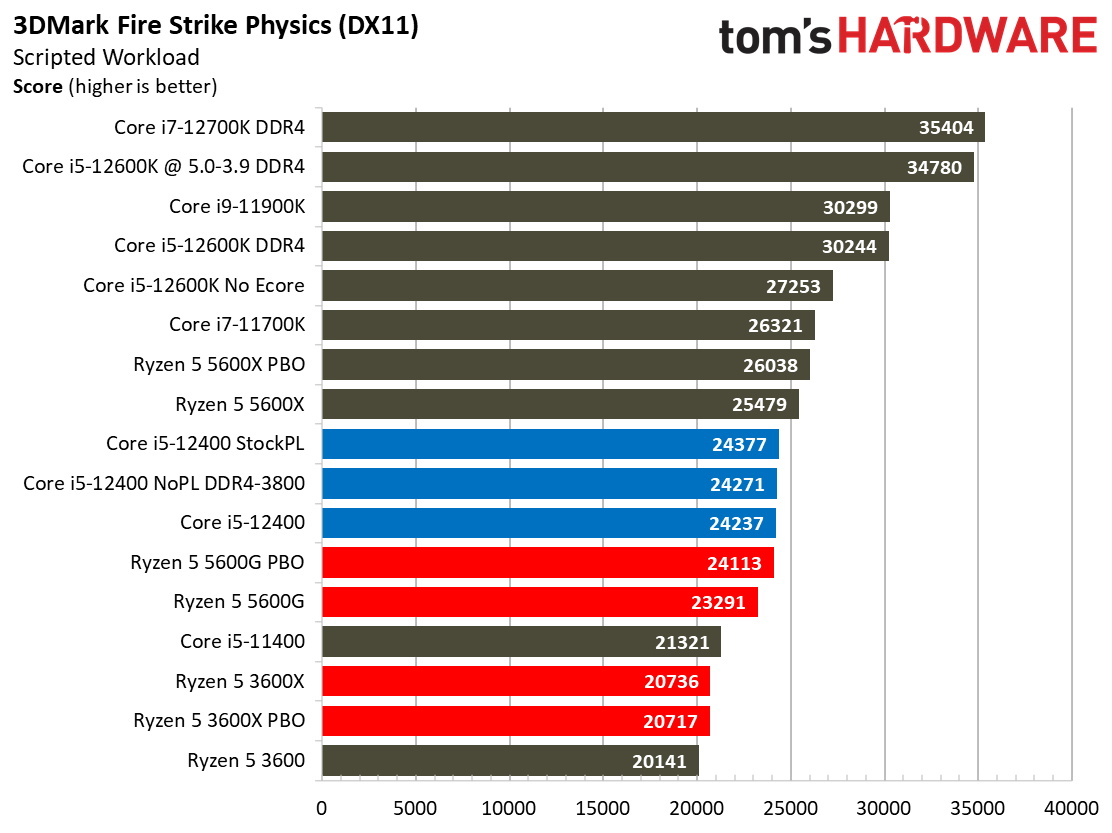
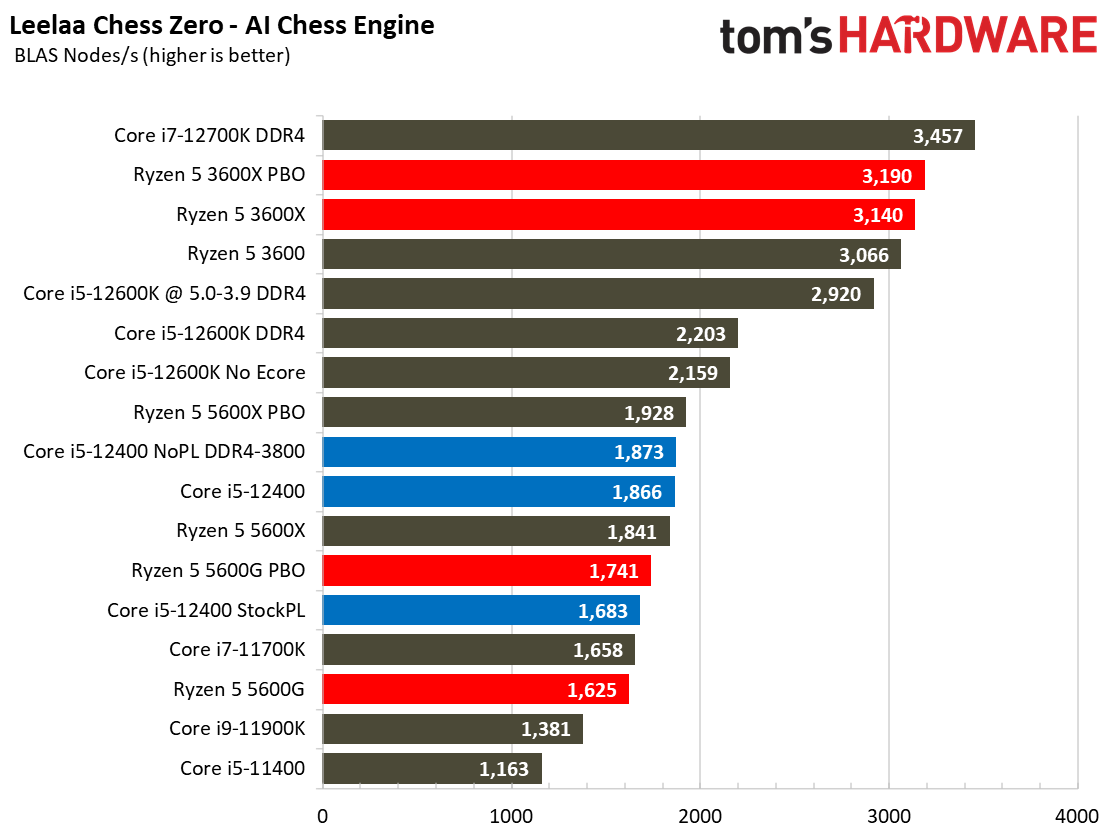

Synthetic benchmarks don't tend to translate well to real-world gaming, but they do show us the raw amount of compute power exposed to game engines. It's too bad most games don't fully exploit it.
Far Cry 6 on Core i5-12400


F1 2021 on Intel Core i5-12400


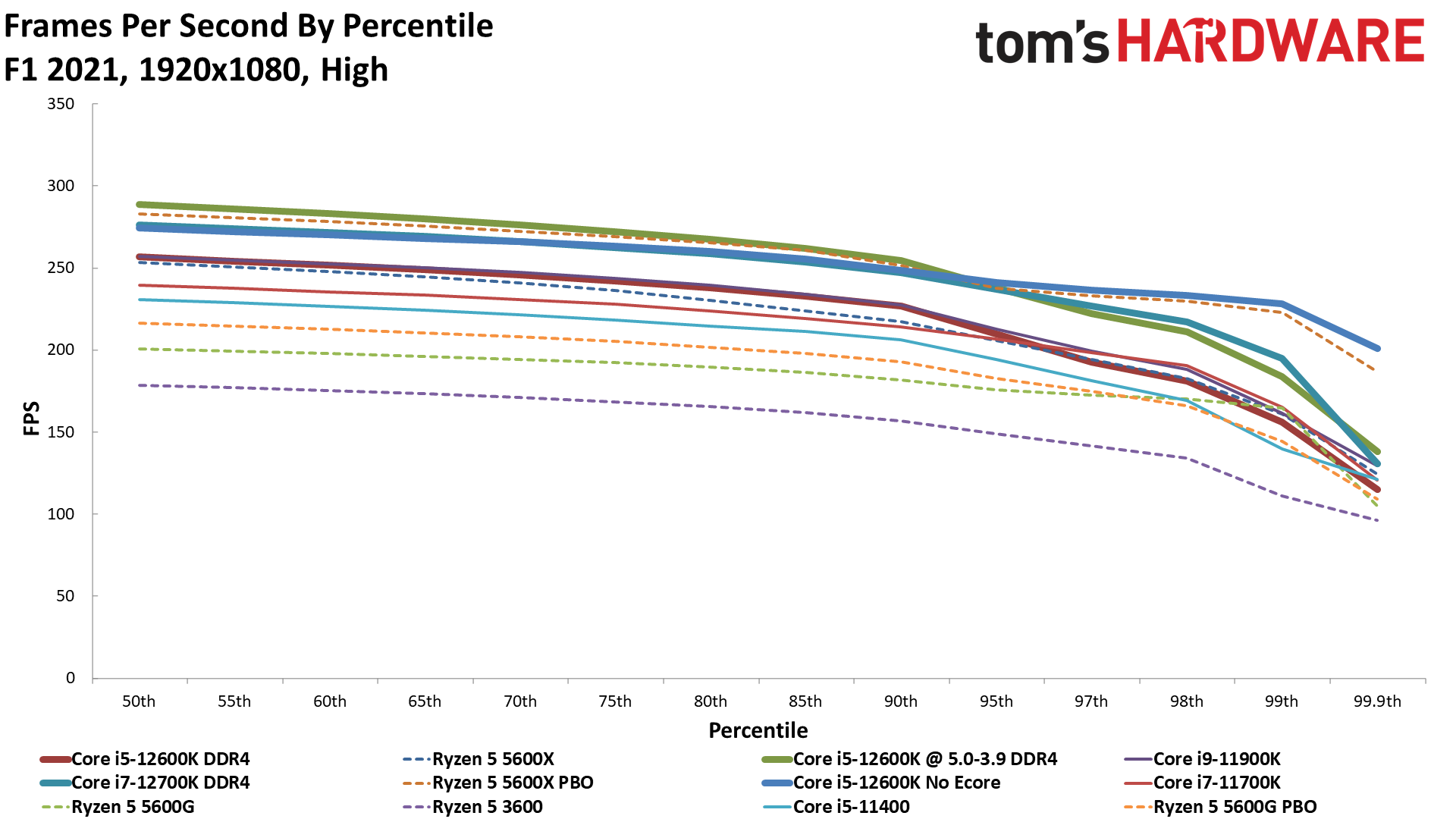
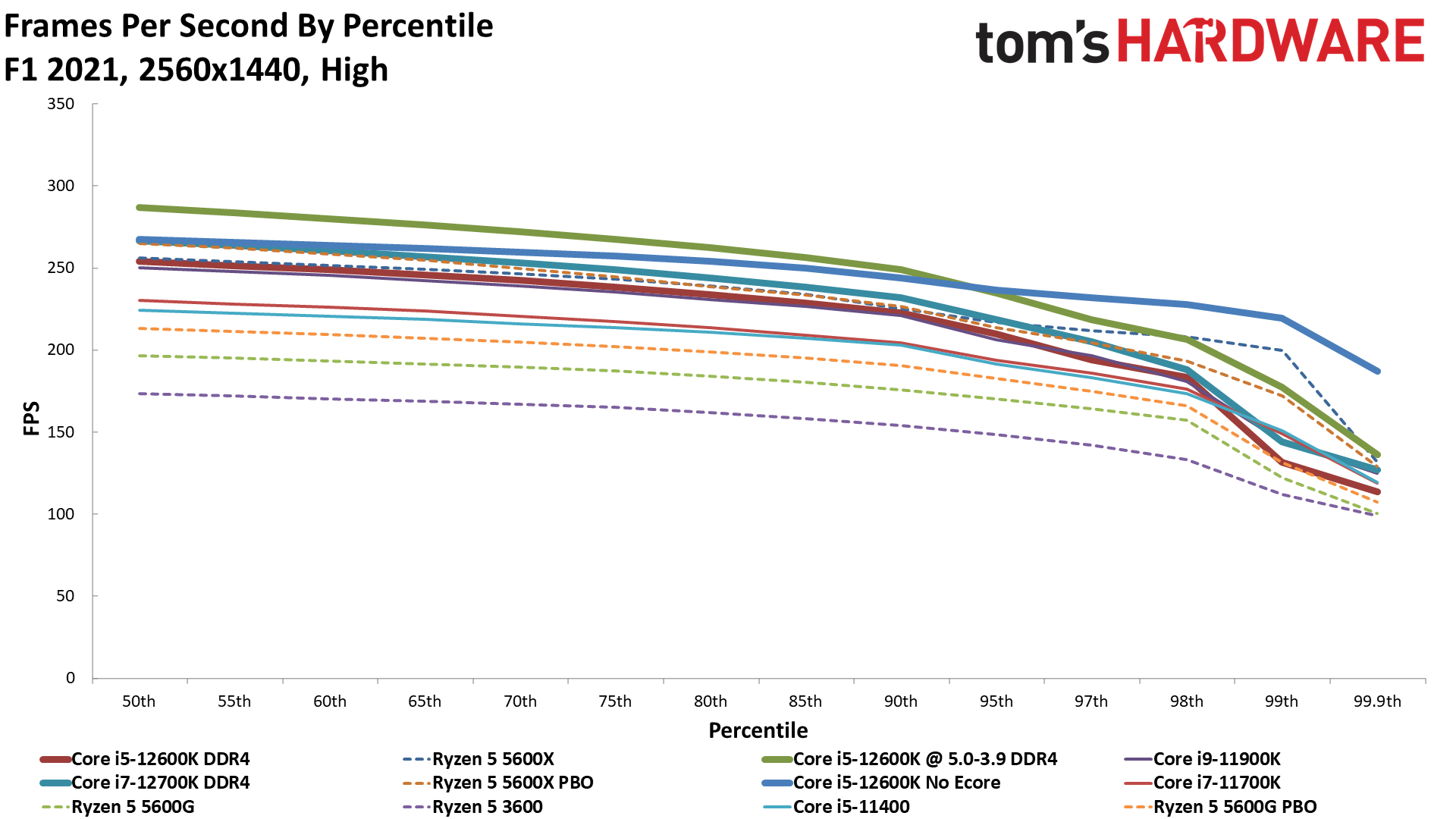
Hitman 3 on Core i5-12400
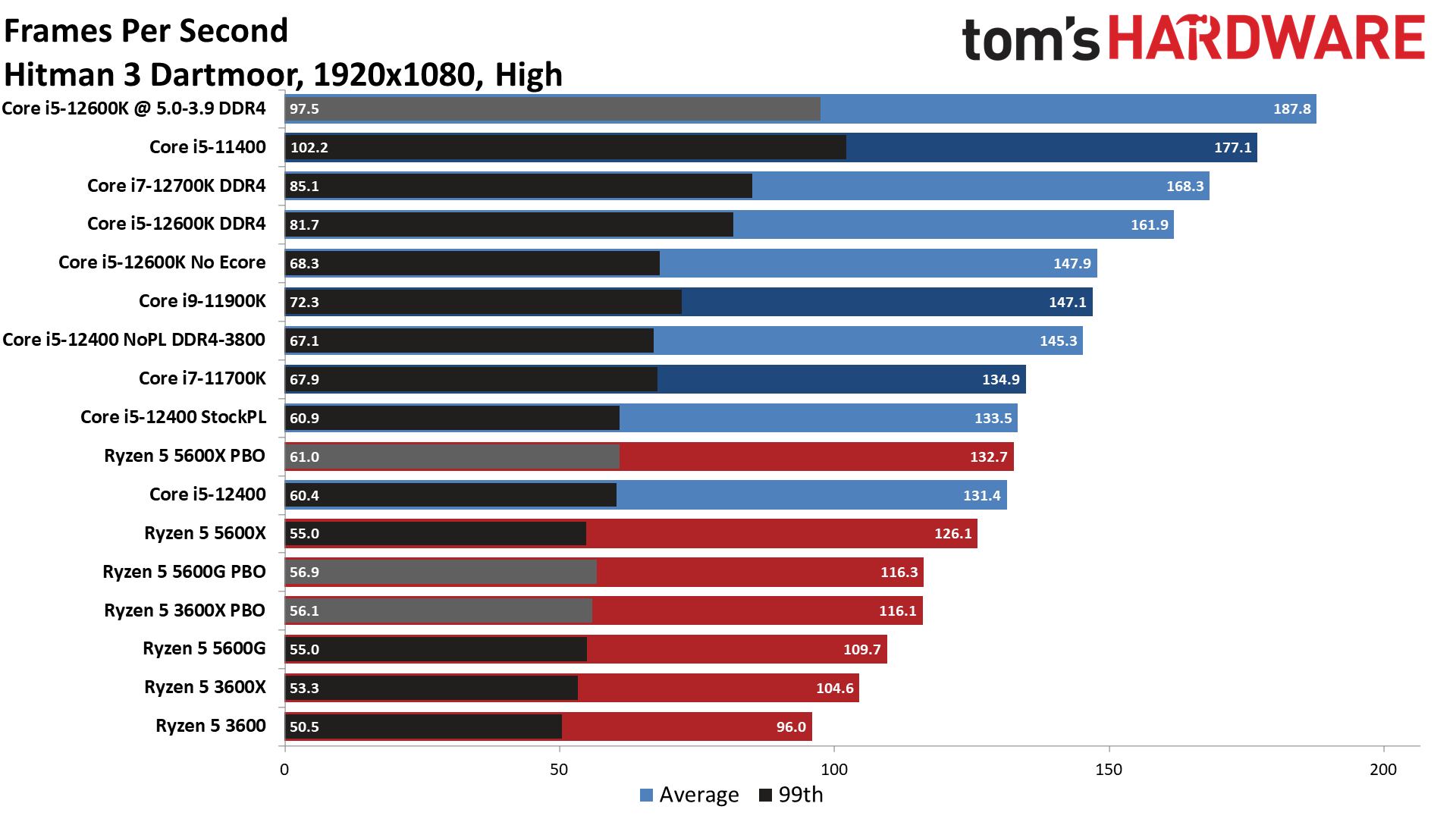

Horizon Zero Dawn on Core i5-12400




Microsoft Flight Simulator 2021 on Core i5-12400


Red Dead Redemption 2 on Core i5-12400


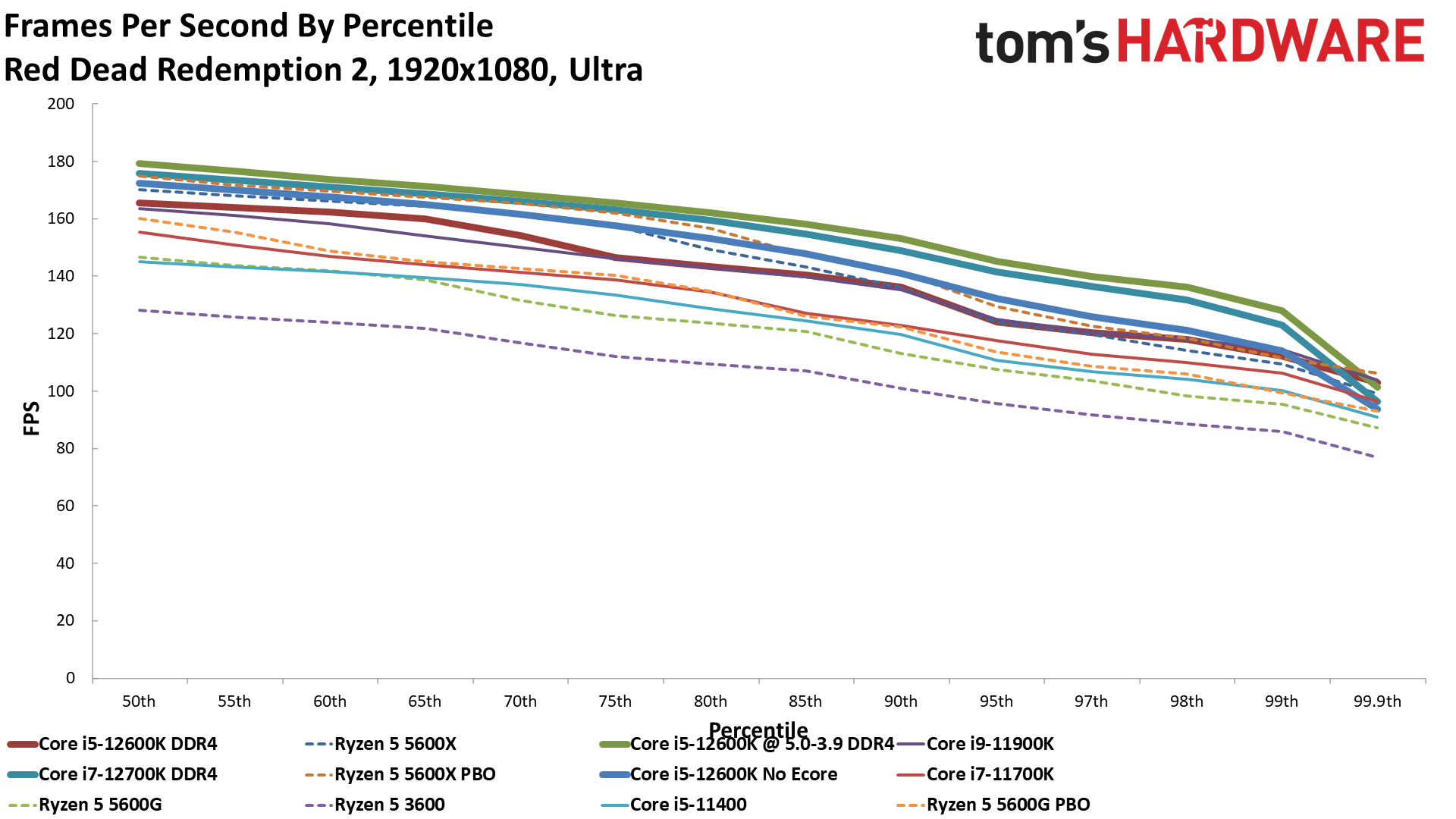

Watch Dogs Legion on Core i5-12400




Core i5-12400 Application Benchmarks — The TLDR


We can boil down productivity application performance into two broad categories: single- and multi-threaded. These slides show the geometric mean of performance in several of our most important tests in each category, but be sure to look at the expanded benchmark results further below.
The Core i5-12400 is impressive in our cumulative measure of single-threaded performance. As expected, we don't see any meaningful differences between the 12400's different power settings, but the 12400 doesn't need too much help. The chip is 2.3% faster than the Core i9-11900K, 6% faster than the 11700K, and an incredible 15.7% faster than the 11400.
Zooming out to the Ryzen comparables reveals that the 12400 is 13.5% faster than the Ryzen 5 5600G in single-threaded work (10% faster after tuning the 5600G), and a whopping 24% and 27% faster than the Ryzen 5 3600X and 3600, respectively. You'll have to look to other Alder Lake chips to find faster performance in single-threaded work — as you can see in our CPU Benchmark hierarchy, even the vaunted Ryzen 9 5950X isn't as fast as the Core i5-12400 in single-threaded work.
We can see the advantage of uncorking the power restrictions in threaded workloads, as the Core i5-12400 is 7% faster after our alterations. That said, we see a different picture in threaded productivity work where the 12400 obviously isn't in the same league as Ryzen 9 chips.
However, the 12400 is still plenty competitive against the Ryzen 5 models, even beating the vaunted Ryzen 5 5600X by 2.3% at standard settings and 6.7% after tuning both chips. That's impressive given the 12400's much more forgiving price tag, but as you'll see in the benchmarks below, the Ryzen 5 5600X does carve out wins in more than a few threaded applications.
We see larger gains over the Ryzen 5 5600G, 3600X and 3600, with the stock 12400 taking leads of 15.8%, 22.4%, and 23.6%, respectively. Frankly, AMD just doesn't have any worthy competing chips at this price point for this type of work.
The Core i5-12600K earns its price tag for threaded productivity tasks: The 12600K is ~21.7% faster in threaded work than the 12400, and that percentage climbs in some workloads. As you can see by the results with the 12600K's E-cores disabled, those tiny little E-cores pull a lot of weight in threaded work. Overall, the 12600K is 12.3% faster with the E-cores active than it is with them disabled.
The 12400 may not have as much threaded heft as the 12600K because of its lack of E-cores, but it does pretty well against the previous-gen Core i5-11400 with a 12.4% lead. As expected, it can't keep pace with the 11900K and 11700K in threaded work.
Overall the Core i5-12400 offers a wonderful blend of performance in both single- and multi-threaded apps given its price point. You'll have to look to Intel's own Alder Lake family for faster single-threaded performance, and the 12400 beats the price-comparable Ryzen models (and even the $110 more expensive Ryzen 5 5600X) in threaded applications by convincing margins.
| Tom's Hardware - Application Benchmarks | Single-Threaded | Multi-Threaded |
| Core i9-12900K DDR4 | 100% | 100% |
| Core i9-12700K DDR4 | 97.3% | 85.7% |
| Core i5-12600K DDR4 | 95.9% | 66.6% |
| Core i5-12400 noPL DDR4-3800 | 87.1% | 52.2% |
| Core i5-12400 | 86.9% | 52.2% |
| Core i5-12400 StockPL | 87.1% | 48.8% |
| Core i9-11900K | 84.9% | 63.3% |
| Core i5-11700K | 81.8% | 63.9% |
| Ryzen 5 5600G | 75.1% | 43.9% |
| Ryzen 5 3600X | 66% | 40.5% |
Rendering Benchmarks on Core i5-12400













AMD's onslaught against Intel began with a commanding lead in rendering work, particularly Cinebench. However, that lead has waned with the arrival of Alder Lake, as the Core i5-12400 takes a somewhat slim lead over the Ryzen 5 5600X in both the Cinebench single- and multi-threaded tests while taking much more substantial leads over the 5600G, 3600X, and 3600.
The 12400 is particularly strong in single-threaded rendering tasks but equally adept in the threaded benchmarks. Overall, the Core i5-12400 dominates the comparably-priced Ryzen chips in these tests.
AMD's strongest showing in these tests comes from the $300 Ryzen 5 5600X during the C-Ray and Corona benchmarks. The 5600X is also strong in the four Blender renders, but it wins two and loses two, equating to a wash.
Encoding Benchmarks on Core i5-12400










Web Browsing on Intel Core i5-12400

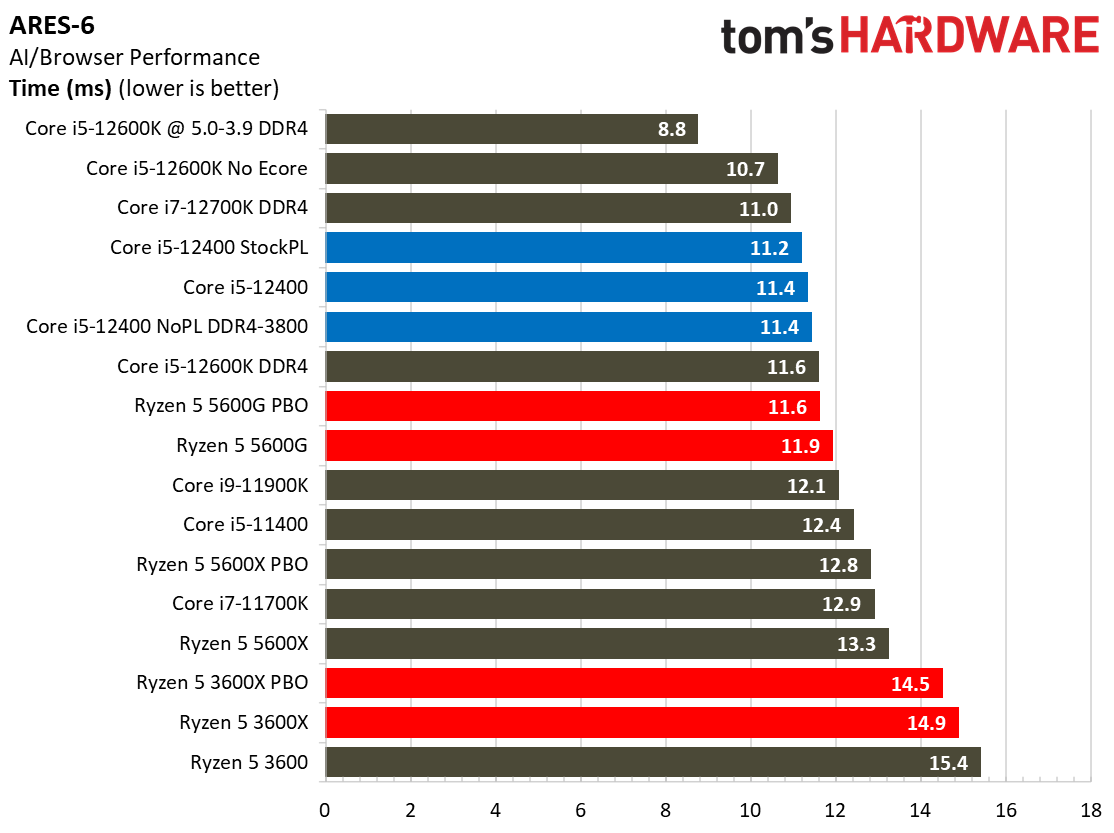


The ubiquitous web browser is one of the most frequently used applications. These tests tend to be lightly threaded, so a snappy response time is critical. The Core i5-12400 beats all competing Ryzen processors in Jetstream 2 and ARES-6, but the Ryzen 5 5600X edges past in WebXPRT 3.
The Microsoft Edge browser is our lone example of a browser that benefits from threaded horsepower. Here the Core i5-12400 beats all competing Ryzen chips, proving it is quite versatile in browser work.
Adobe Premiere Pro, Photoshop, and Lightroom on Core i5-12400

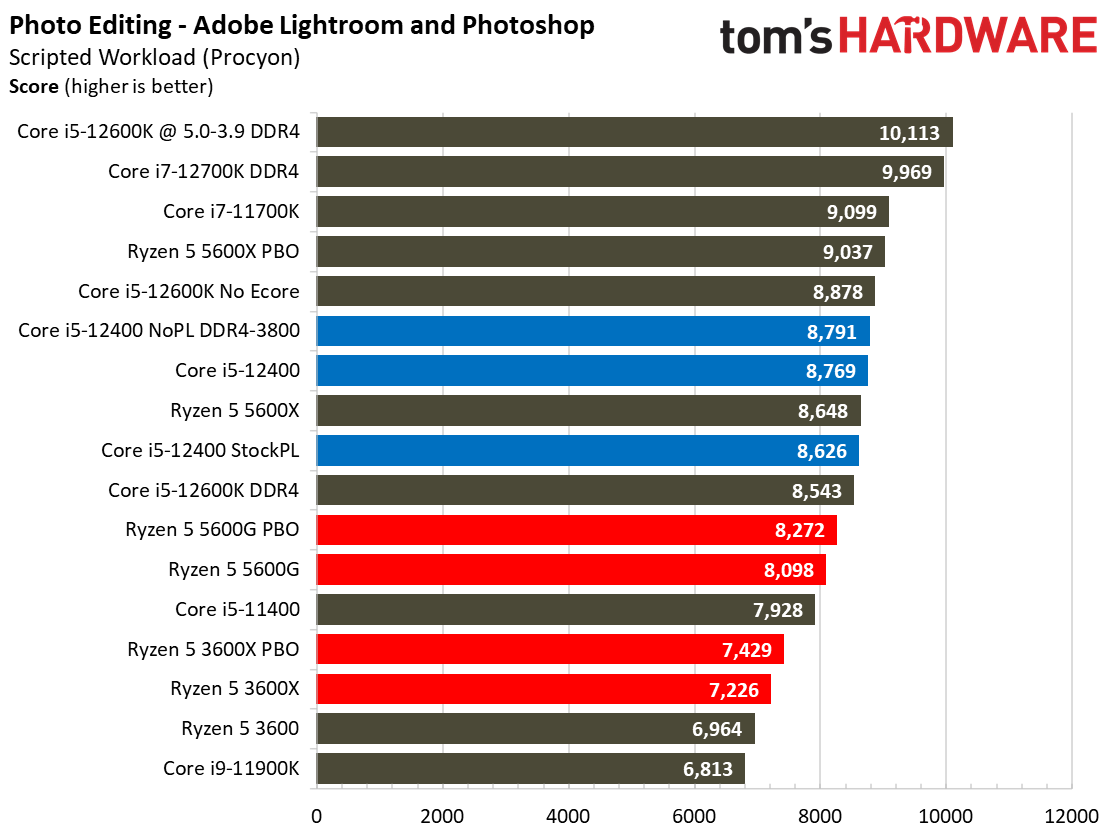
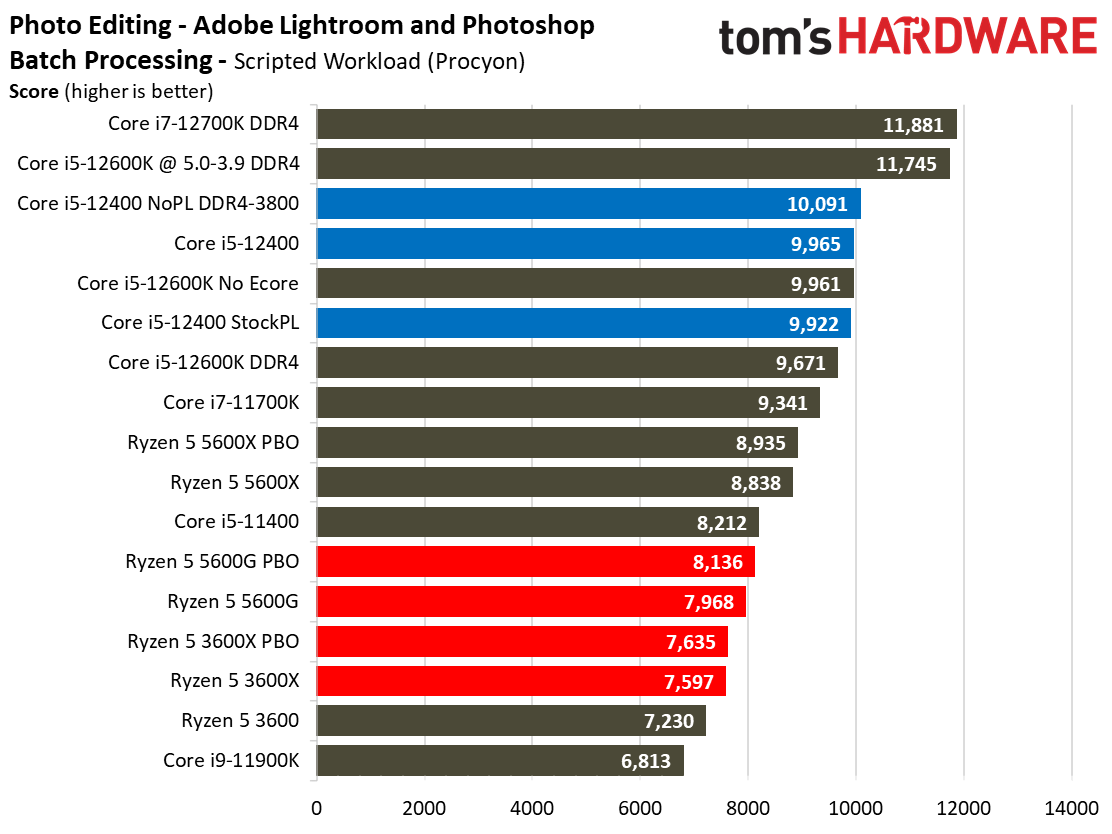
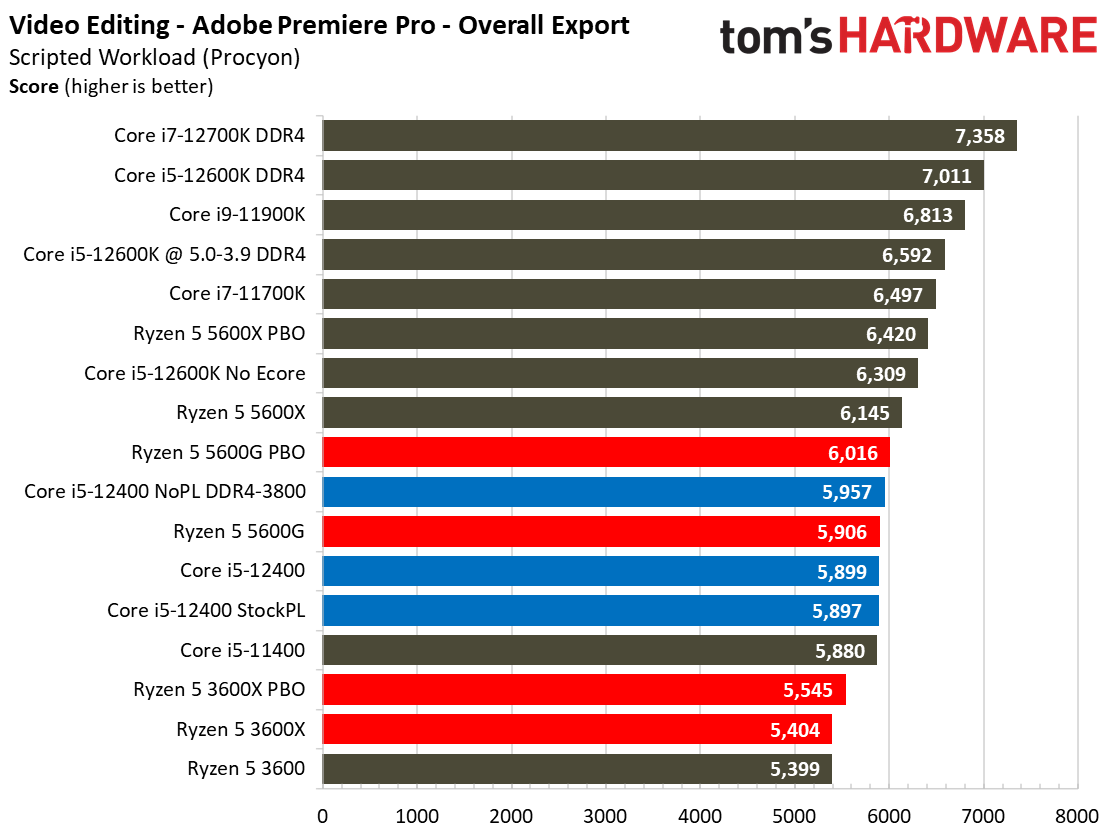


We've integrated the UL Benchmarks Procyon tests into our suite to replace the aging PCMark 10. This new benchmark runs complex Adobe Premiere Pro, Photoshop, and Lightroom workflows with the actual software, making for a great real-world test suite.
The Core i5-12400 trails the Ryzen 5 5600X and overclocked 5600G in the Adobe Premiere Pro video editing benchmarks but takes the lead in the Adobe Lightroom and Photoshop photo editing benchmarks.
Office and Productivity on Core i5-12400
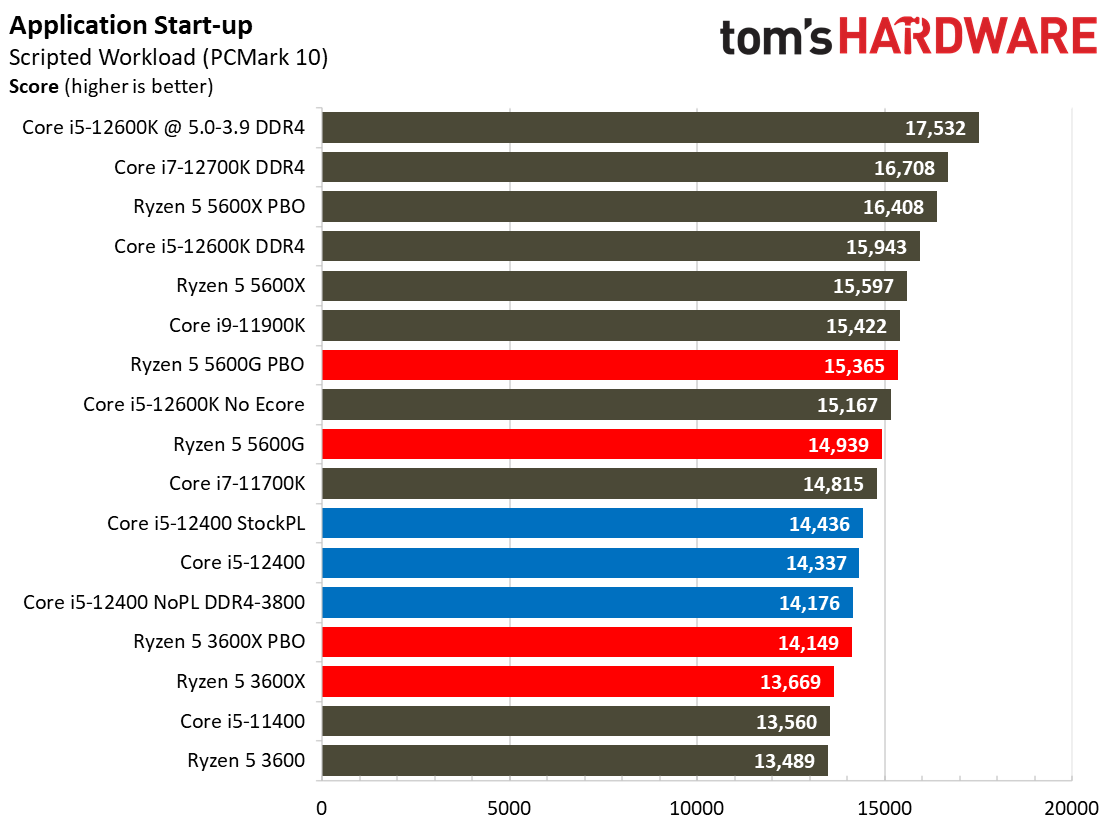




The Core i5-12400 provides snappy application load times, but the Ryzen 5 5600G and 5600X are faster, which isn't too surprising given their higher price points. Conversely, the 12400 beats all of the competing Ryzen chips in the Microsoft Office suite.
Compilation, Compression, AVX Benchmarks on Core i5-12400

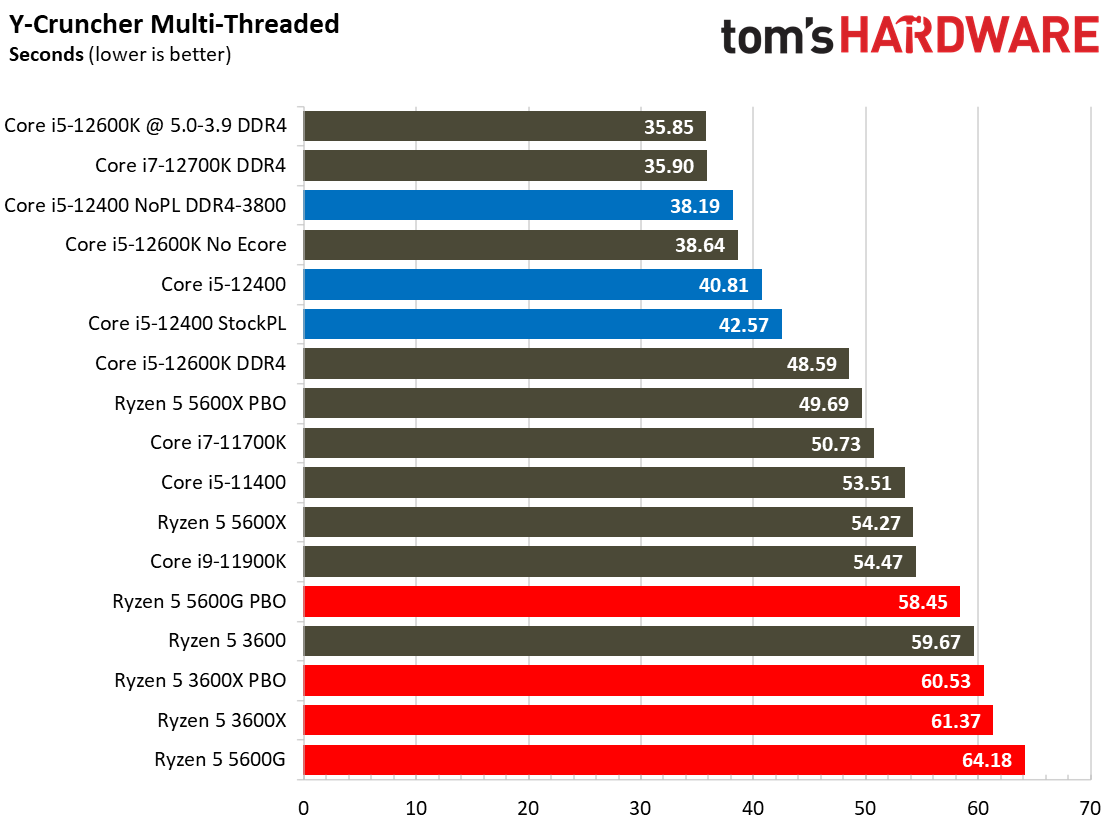

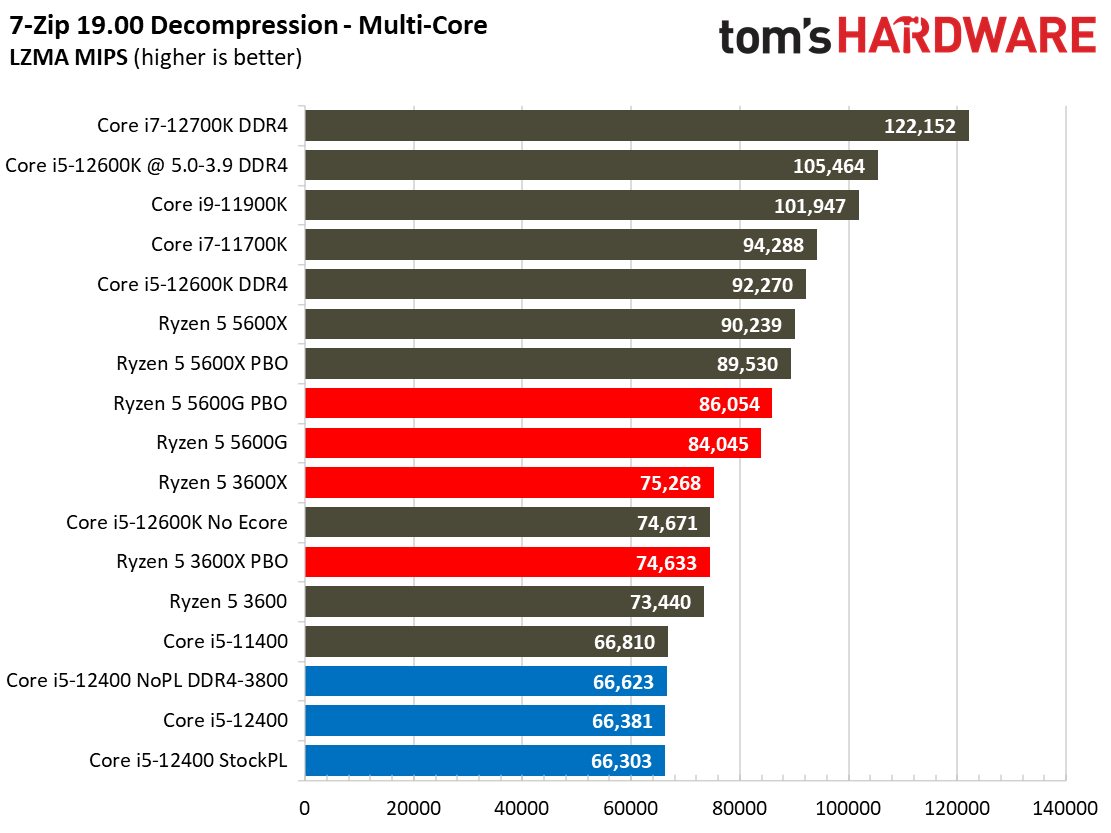



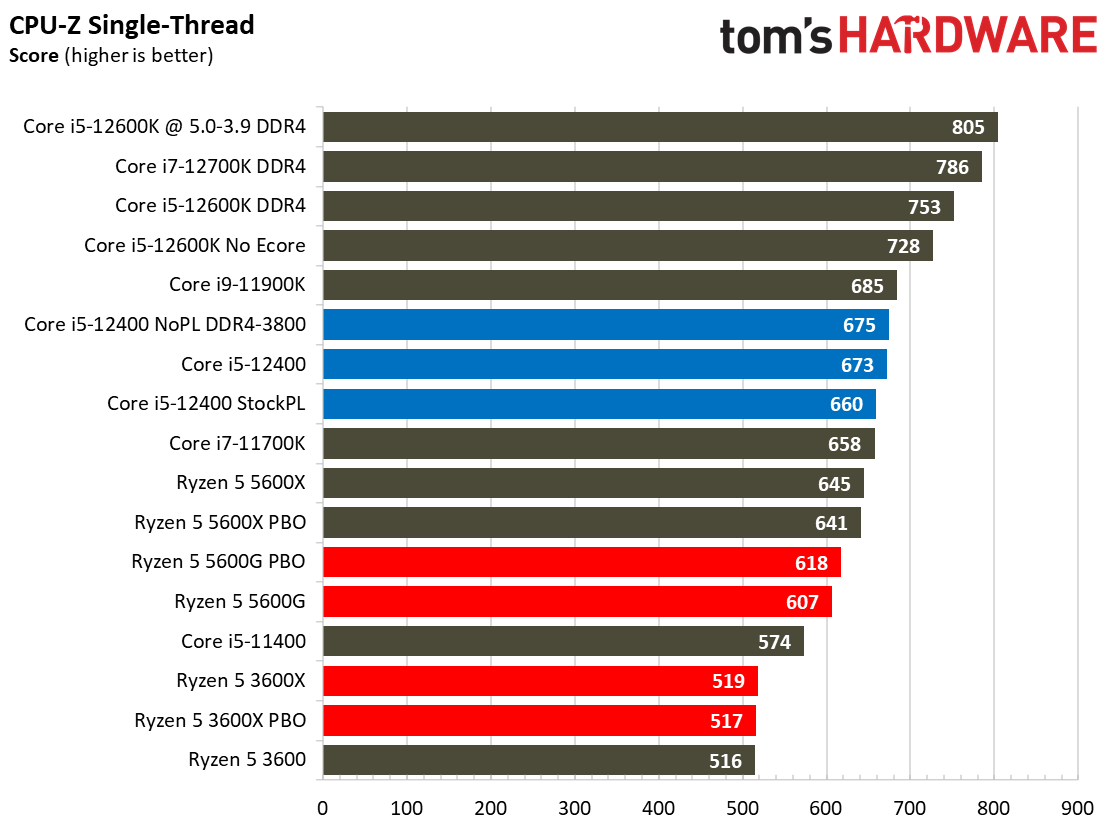



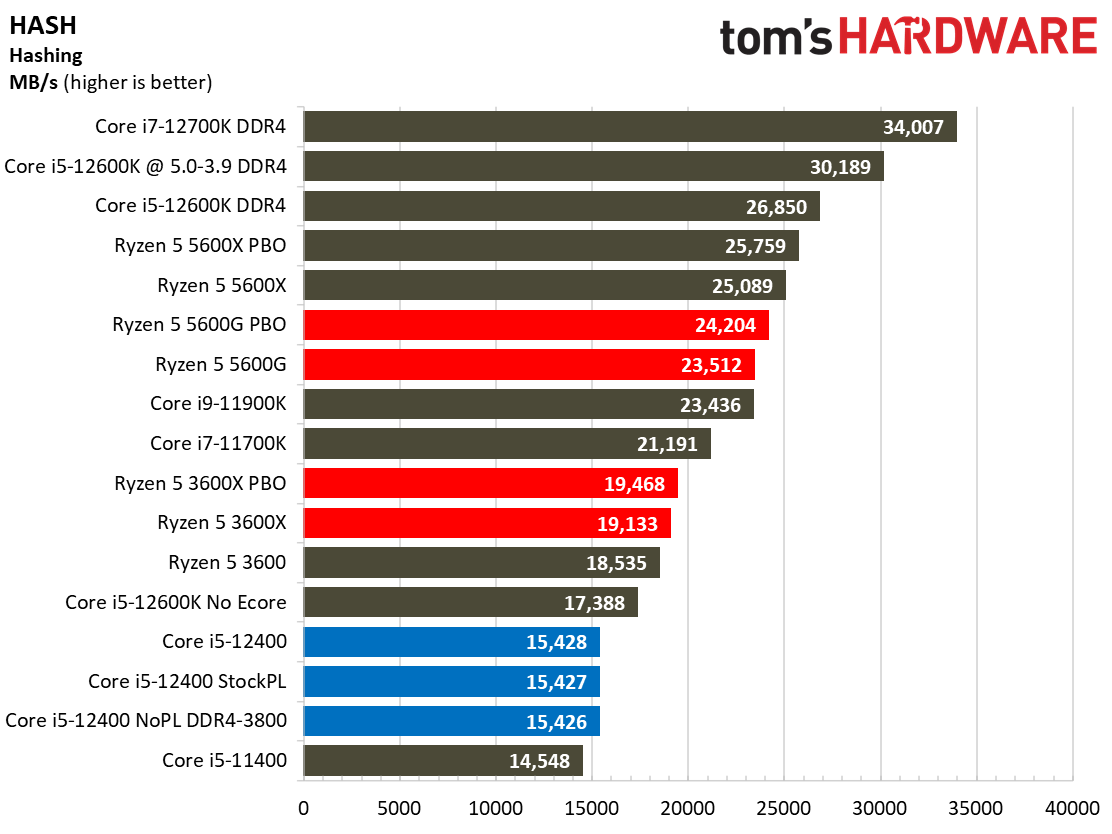

This grab bag of various tests finds the Core i5-12400 scoring several more wins. From the exceedingly branchy code in the LLVM compilation workload to the massively parallel molecular dynamics simulation code in NAMD, the 12400 is impressive.
Meanwhile, AMD's higher-end Ryzen 5 5600X carves out wins in the NAMD, compression/decompression, and encryption workloads. Still, all of the price-comparable Ryzen models trail the Core i5-12400 across the entire gamut of tests.
Mid-range Gaming Dominance
Like the rest of the Alder Lake family, the Core i5-12400 will come to market with disruptive pricing as part of Intel's new bare-knuckle price war with AMD. That's particularly painful as Intel attacks the sub-$200 segment that AMD has largely abandoned.
The ~$185 Core i5-12400 beats the $299 Ryzen 5 5600X and $259 Ryzen 5 5600G in key areas. Putting the Core i5-12400 up against AMD's price-comparable models isn't a fair fight; the Core i5-12400 beats them by huge margins, but that's because the $240 Ryzen 5 3600X and $199 Ryzen 5 3600 leverage the aging Zen 2 architecture.
They're also facing a tremendous competitor. Consider this: With the right tuning, the 12400 is even slightly faster at 1080p gaming than the previous-gen $549 Core i9-11900K flagship at stock settings, which is impressive.
Intel's Alder Lake pricing is solid, but the company's decision to initially bring only Z690 motherboards to market took a bit of the shine off the value proposition at launch. However, we're on the cusp of the release of the more affordable B- and H-series motherboards, which should bring a much lower cost of entry to the Alder Lake platform. Unfortunately, we don't have details of those motherboards to share yet, but we're sure that you'll learn more in the coming days.
Below, we have the geometric mean of our gaming test suite at 1080p and 1440p and a cumulative measure of performance in single- and multi-threaded applications. Remember that we conducted the gaming tests with an RTX 3090, so performance deltas will shrink with lesser cards and higher resolution and fidelity settings.






The Core i5-12400 eschews the hybrid Alder Lake design, instead going with only six P-cores. That doesn't hold the chip back in gaming, though, and the Core i5-12400 now reigns as the mid-range gaming CPU champ.
There are a lot of impressive 12400 gaming stats to throw around, but some are more telling than others. For instance, the Core i5-12400 is 1.9% faster than AMD's venerable ~$299 Ryzen 5 5600X at stock settings. Overclocking both chips yields a tie, an impressive showing considering the 12400 costs ~$110 less. The Core i5-12400 is also 16.8% faster than the $250 Ryzen 5 5600G.
AMD's decision to prioritize higher-end, higher-margin chips makes good business sense, but it leaves the entire high-volume budget segment to Intel. As a result, AMD's Zen 2-powered $240 Ryzen 5 3600X and $200 Ryzen 5 3600 are the company's only price-comparable chips. They're woefully unprepared for the onslaught: The Core i5-12400 is 22.7% and 26% faster in 1080p gaming than the Ryzen 5 3600X and 3600, respectively.
The 12400 is just as impressive in lightly-threaded apps. In fact, not a single Ryzen processor beat the Core i5-12400 in our cumulative measure of single-threaded performance, and that includes the $800 Ryzen 9 5950X. The margins against AMD's comparable chips aren't slim, either. You'll have to look to other Alder Lake chips to find faster performance in single-threaded work.
The Core i5-12400's generational improvements in threaded work are a bit tamer. It is 'only' 12.4% faster than the previous-gen Core i5-11400, but we still see impressive performance over the Ryzen competition. Even though the 5600X carves out some wins in some applications, at stock settings, the 12400 is 2.3% faster than the 5600X in our cumulative measure of threaded work and 6.7% faster after overclocking. That's surprising given the pricing delta.
Frankly, AMD doesn't have any worthy competing chips for threaded work at the 12400's price point. We see larger leads for the 12400 over the Ryzen 5 5600G, 3600X, and 3600, with the Core i5-12400 taking leads of 15.8%, 22.4%, and 23.6%, respectively.
That means the Core i5-12400 wins against the price-comparable Ryzen chips in every performance category, and even beats a few of the more expensive models. Of course, you also have to consider that you can get the graphics-less Core i5-12400F for ~$25 less. That's an excellent price point for access to this level of performance.
Given the 12400's impressive price-to-performance ratio, the question becomes whether it's worth it to step up to the Core i5-12600K. If you're focused primarily on gaming, the Core i5-12600K is 2.5% faster at stock settings, which isn't worth the premium. However, the 12600K earns its price tag if you're overclocking. The 12600K is one of the best overclockers we've seen in several chip gens, delivering up to 15% higher gaming performance after tuning. That gives it an 11.5% lead over a tuned 12400. The 12600K also proves its worth in threaded applications, where it is ~21.7% faster than the 12400, primarily on the strength of its four additional E-cores.
The Core i5-12400 has a much more modern platform than AMD's AM4 ecosystem. Leading-edge DDR5 and PCIe 5.0 interfaces add some cost, but support for DDR4 B660 motherboards helps reduce that overhead. You won't need DDR5 memory to unlock the best gaming performance, and that's a good thing because DDR5's high pricing doesn't make sense for this class of chip.
Alder Lake has delivered a decisive blow to AMD's entire Ryzen 5000 family. AMD will respond with its 3D V-Cache processors with up to 192MB of L3 cache per chip, imparting up to 15% more gaming performance. Those chips arrive this year, but we're not sure if the added premium of the 3D V-Cache tech will make it worth manufacturing souped-up Ryzen 5 models to compete with the Core i5-12400. Time will tell.
The 12400 serves up solid performance in all manner of threaded productivity applications, and its snappy single-threaded performance beats even the fastest Ryzen 5000 processors. Additionally, the Core i5-12400 delivers incredible levels of gaming performance but at a much lower price point than any comparable AMD processor, setting a new bar for mid-range gaming chips. For gamers looking for the best value, the Core i5-12400 is now the uncontested best mid-range CPU for gaming, while the Core i5-12600K is the best option for overclockers.
| Intel Socket 1700 DDR4 (Z690) | Core i7-12700K, Core i5-12600K, Core i5-12400 |
| Row 1 - Cell 0 | MSI Z690A WiFi DDR4 |
| Row 2 - Cell 0 | 2x 8GB Trident Z Royal DDR4-3600 - Stock: DDR4-3200 14-14-14-36 |
| Intel Socket 1200 (Z590) | Core i9-11900K, Core i7-11700K, Core i5-11400 |
| Row 4 - Cell 0 | MSI Z590 Godlike |
| Row 5 - Cell 0 | 2x 8GB Trident Z Royal DDR4-3600 - Stock DDR4-3200/2933 Gear 1 |
| AMD Socket AM4 (X570) | Ryzen 5 5600X, 5600G, 3600X, 3600 |
| MSI MEG X570 Godlike | |
| Row 8 - Cell 0 | 2x 8GB Trident Z Royal DDR4-3600 - Stock: DDR4-3200 14-14-14-36 |
| All Systems | Gigabyte GeForce RTX 3090 Eagle - Gaming and ProViz applications |
| Row 10 - Cell 0 | Nvidia GeForce RTX 2080 Ti FE - Application tests |
| 2TB Sabrent Rocket 4 Plus | |
| Silverstone ST1100-TI | |
| Row 13 - Cell 0 | Open Benchtable |
| Row 14 - Cell 0 | Arctic MX-4 TIM |
| Row 15 - Cell 0 | Windows 11 Pro |
| Cooling | Corsair H115i, Custom loop |
- MORE: Best CPUs for Gaming
- MORE: CPU Benchmark Hierarchy
- MORE: AMD vs Intel
- MORE: All CPUs Content

Paul Alcorn is the Editor-in-Chief for Tom's Hardware US. He also writes news and reviews on CPUs, storage, and enterprise hardware.
-
helper800 Reply
How can it be tested if it is unreleased?DRagor said:How it can be fastest if it is unreleased? :D -
DRagor Reply
With the crystal ball of course ;)helper800 said:How can it be tested if it is unreleased? -
helper800 Reply
Mhhmmm, lol, I did not take into account The Crystal Ball.DRagor said:With the crystal ball of course ;) -
DRagor Anyways, jokes and language nitpicking aside, I'm very curious if indeed H0 chips will consume less power then C0. Could be very interesting for people who just want to pair the CPU with cheapest mobo they can find.Reply -
jacob249358 Reply
If you read the first 2 sentences it says they got one. Did you not click on the article?DRagor said:How it can be fastest if it is unreleased? :D -
RodroX Great, we go from the not available/imposible to get GPUs at decent price, to the not available and imposible to get, and yet not launched CPUs benchmark.Reply
I will just write what I been writing and saying for the last year and a half: intel and amd can keep launching as many CPUs as they can. If I can not upgrade my GPU, because of price and/or availability I couldn't care less about a new CPU.
A real pitty.
..... Well I guess this is good for small, medium and big enterprises who may just need a powerfull desktop PC with integrated gpu. -
jgraham11 Paul, your article is very thorough but some of the testing choices I don't understand:Reply
Why is your 12400 stockPL running above the stock MTP power limits. The "Stock" settings have a Tau of 117 seconds. Almost double the 56 seconds that is the actual stock. Doesn't seem very honest calling it stock when its not.
In your value discussions, you fail to mention the extra cost of the higher cost motherboard that this 12400 would have to be in.
Your comment refering to PCI-E 5.0 lanes working for data storage is incorrect. Only one Asus board currently can do PCI-E 5.0 from m.2.
At the price point of the 12400 and given GPU prices, the 5600G would have been a better comparison, but that would have meant comparing Intel's horrible integrated graphics to AMD's vastly superior onboard graphics... -
Why_Me Reply
Do you know the pricing of the B660 DDR4 boards? If so please list them.jgraham11 said:Paul, your article is very thorough but some of the testing choices I don't understand:
Why is your 12400 stockPL running above the stock MTP power limits. The "Stock" settings have a Tau of 117 seconds. Almost double the 56 seconds that is the actual stock. Doesn't seem very honest calling it stock when its not.
In your value discussions, you fail to mention the extra cost of the higher cost motherboard that this 12400 would have to be in.
Your comment refering to PCI-E 5.0 lanes working for data storage is incorrect. Only one Asus board currently can do PCI-E 5.0 from m.2.At the price point of the 12400 and given GPU prices, the 5600G would have been a better comparison, but that would have meant comparing Intel's horrible integrated graphics to AMD's vastly superior onboard graphics... -
King_V Since the emergence of Ryzen, I've been very much in favor of AMD . . better performance/watt, lower power consumption overall, and competitive, if not superior, performance to Intel.Reply
I am, however, very impressed with the 12400. Were I in the market to buy today, and if there were the B660 or H670 boards available, I'd probably go with this CPU.
The power consumption numbers weren't expressly given in charts comparing to the other CPUs, and I know there's the concern with C0 vs H0, but I am definitely looking forward to those charts when they become available.
So far, though, Intel's got a winner on its hands here.